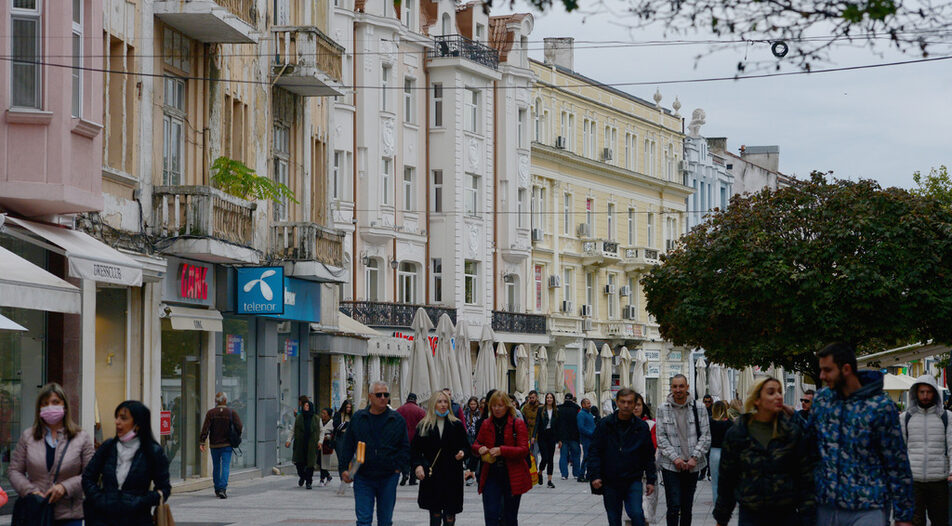- Stara Zagora focuses on rapid economic growth, industrial growth and green projects.
- Plovdiv concentrates on old, expensive road and sports projects without a clear developmental vision.
- Varna relies on well-known projects for 1 billion levs but lacks ambitious plans for a new image and appearance.
- Burgas focuses on what has been missed - industrial zones, a new type of tourism, and the needs of the IT sector.
In the shadows. That's how Bulgarian cities have developed so far. Their planning and major future projects were decided behind closed doors, and then funding was requested either from the EU or from the capital Sofia.
This time it could have been so different. The new plans for the integrated development of municipalities (called PIROs) form the basis for which all money for cities over the next seven years will be spent.
In recent months, larger cities have adopted, or are getting ready to adopt, their plans for the 2021-2027 period. European funding for the new period can be "unlocked" this year, and municipalities are preparing. That's why Capital Weekly reviewed the PIROs of four of the largest municipalities outside Sofia - to identify their focus and their promises.
Ready with the plans, waiting for the money
You can think of PIROs as children's letters to Santa: the trick is to cram them with everything in your wish list in the hope that you will get at least a few of your dream items. Clearly, the wishlists of Stara Zagora, Plovdiv, Varna and Burgas will not be completely fulfilled (or even 50% of them, if we are realistic).
For example, the PIRO of Plovdiv alone envisages investments of about one billion leva, of which 35% are expected to be covered by EU funds. This means 350 million levs (or 178 million euro) euro funding. By comparison - under the future European Regional Development Fund (ERDF) Plovdiv will be in a cluster with several other cities, whose total value is nearly 300 million levs.
The situation is even more extreme in Stara Zagora, where 1.5 billion levs out of a total of 1.6 billion levs featured in PIRO stems from European funding. Although this is the region that will benefit the most from the coal transition, it is clear that such hopes are exaggerated.
Pending programs
Like other plans made by the administration (for example, the already famous Recovery Plan), these suffer from several defects. The main one is that it includes all backward, unfinished or half baked plans from previous years. The new, fresh ideas that promise real change are not that many.
Some are ambitious (Stara Zagora), innovative (Burgas), others are inert (Varna) or just ill-conceived (Plovdiv).
The other problem is that there is not much time - the second year of the seven is already underway, and many of the projects set in the PIROs are just ideas and do not have specific frameworks. "It is already the middle of 2022 and we do not have a single program that has been finalized, and there are no guidelines for applying. This worries us a lot. The indicative value does not matter if we do not have open programs," the Deputy Mayor of Burgas for Strategic Development and Ecology, Digitalization Vesna Baltina told Capital Weekly.
However, the new programs are expected to start this summer since the European Commission accepted the Recovery Plan.
#The next 7
Stara Zagora
1.65 billion levs
The transformation of Stara Zagora into a green city is strongly represented in its PIRO, as the biggest projects are related to green policy. Photovoltaic installations are planned on some public and private buildings (industrial and residential). Energy efficiency measures and renewable energy sources are the other big priorities.
"Stara Zagora has another 'financing line'- the Territorial Just Transition Plan, which is expected to provide additional hundreds of millions of levs. This predetermined the scale of the PIRO," says Rumyana Grozeva, head of the Regional Development Agency in Stara Zagora.
One of the important projects is a new industrial zone with an airport. Grozeva explains that this is an extension of the already existing "Zagore" zone - as this is stage II, called "Zagore - Elenino". She adds that private investors are also intensely interested in the construction of photovoltaic parks in the region due to the favorable climatic conditions and the already built energy infrastructure in the area of the Maritza East Complex.
#The next 7
Plovdiv
1.04 billion levs
It is difficult to say that there is any inspiring ambition in Plovdiv's plan, given that it relies heavily on repairs, widening of roads and several sports venues. The main projects with the potential to change the city - the city railway, the railway connection to Krumovo Airport, and the water reservoir "Vacha", are marked only by indicative values and do not depend on the municipality.
"Even the municipality itself knows the projects are unfeasible and only pro forma," said Dobromira Kostoyava, co-chair of Green Movement, and a municipal councilor in Plovdiv. The problem with the railway in its current form is that even if it happens, it will not provide a solution to the traffic and dirty air, because it is only on the outskirts of the city.
The largest new and surprising project is the one for the International Theater for Contemporary Performing Arts (for 100 million levs). As this is a new project, we can only wait to see what will happen.
#The next 7
Varna
1 billion levs
Varna's plan for the next seven years seems to go by default - it includes projects such as the light rail and innovation district, but the bigger picture is missing. The question is how all these tasks on its "to-do list" will revamp Varna's image, so that the city is recognizably transformed in the future.
Varna plans to allocate most of its funds - 320 million levs - for the so-called Innovation district, near the building of the Institute of Hydro- and Aerodynamics. The project is called "University Center for Innovative Practices in Marine Therapy and Rehabilitation". According to Svilen Spasov, who is the initiator of many ideas that move cities forward, these 320 million levs are rather "unrealistic", as his fear is how the project will be implemented.
"The meaning of the "neighborhood of innovation'' is contained in the word innovation. The city should invite companies that are the main drivers of the innovation process in Bulgaria. Also, a quality team is required," he explained.
A large part of future funding is set aside for health - for the Center for Innovative Breast Research, Center for Maintenance of High-Tech Medical Equipment at the Medical University (MU), dormitories at MU, Laboratory for Clinical Testing of New Technologies (see chart).
# The next 7
Burgas
752 million levs
The focus is on the city's economic development, which will come from the construction of a children's hospital, a railway to the airport, expansion and investment in industrial areas, and opening of the rest of the port of Burgas to the people.
"Tourism is a determinant of our economy and we have suffered a lot from the pandemic over the last two years, so we have rethought the way we support tourism. We are now focusing on offering an experience," Baltina told Capital Weekly.
Burgas is most proud of the planned Children's Hospital, as it is an "integrated territorial investment", and there are additional features such as children's offices, social housing for young doctors, and staff training (which makes nearly 100 million investment). It is due to be built next to the large university state hospital.
Another significant project is the train from Sarafovo to the railway station. There is no indicative budget for the 13-kilometer section in the PIRO, but estimates are for around 100 million levs. However, whether it will be implemented depends entirely on the new Transport program.
Burgas is geographically limited by the lakes and doesn't have many opportunities to grow. That's why the city pays attention to its industrial zones. Millions of levs are going to be invested there in the future, as 50 million levs out of a total of 75 million levs are planned just for the North industrial zone.
And because Burgas is targeting IT companies, there is another project - "for a technology park with outsourced jobs, strong internet and video surveillance," added the deputy mayor Baltina.
- Stara Zagora focuses on rapid economic growth, industrial growth and green projects.
- Plovdiv concentrates on old, expensive road and sports projects without a clear developmental vision.
- Varna relies on well-known projects for 1 billion levs but lacks ambitious plans for a new image and appearance.
- Burgas focuses on what has been missed - industrial zones, a new type of tourism, and the needs of the IT sector.
In the shadows. That's how Bulgarian cities have developed so far. Their planning and major future projects were decided behind closed doors, and then funding was requested either from the EU or from the capital Sofia.












